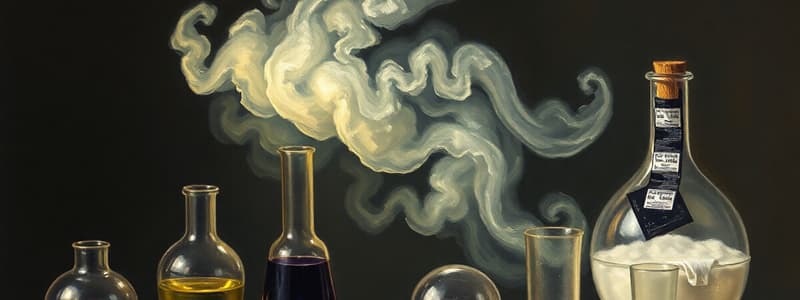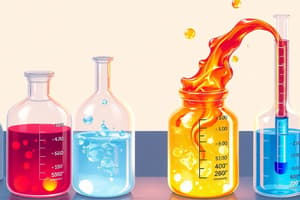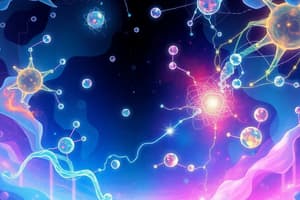Podcast
Questions and Answers
Why is it dangerous to wear contact lenses in the lab? (Select all that apply)
Why is it dangerous to wear contact lenses in the lab? (Select all that apply)
- The plastic reacts with acids
- They don't protect well enough
- Glasses protect better than lenses
- Liquid can be trapped under them (correct)
Why should you never use a CO2 based extinguisher on a person?
Why should you never use a CO2 based extinguisher on a person?
- CO2 is toxic
- CO2 is freezing cold (correct)
- The person would suffocate
- CO2 is corrosive
What do you have to do before leaving the lab, to make sure you don't carry traces of chemicals outside?
What do you have to do before leaving the lab, to make sure you don't carry traces of chemicals outside?
Take off your lab coat and wash your hands
What is the first thing you have to do if there is a fire in the lab?
What is the first thing you have to do if there is a fire in the lab?
What kind of phase change is happening to particles that transition from a solid to a gas state?
What kind of phase change is happening to particles that transition from a solid to a gas state?
What kind of phase change is happening to particles that transition from a gas to a solid state?
What kind of phase change is happening to particles that transition from a gas to a solid state?
What kind of phase change is happening to particles that change from a gas to a liquid?
What kind of phase change is happening to particles that change from a gas to a liquid?
Which of these is NOT matter?
Which of these is NOT matter?
To which of the three main chemical classes does Mercury (Hg) belong?
To which of the three main chemical classes does Mercury (Hg) belong?
What are the different colors caused by that we could see in the flame test?
What are the different colors caused by that we could see in the flame test?
Which groups of elements have a full octet of electrons?
Which groups of elements have a full octet of electrons?
In the standard periodic table, what does the atomic number represent?
In the standard periodic table, what does the atomic number represent?
What does KCl actually stand for?
What does KCl actually stand for?
What happens when ionic compounds dissolve in water?
What happens when ionic compounds dissolve in water?
What's the charge of the K ion?
What's the charge of the K ion?
When K+ and Cl- form an ionic bond, how are they held together?
When K+ and Cl- form an ionic bond, how are they held together?
Which are the subatomic particles of an atom?
Which are the subatomic particles of an atom?
How many electrons are in the atom of Magnesium (Mg)?
How many electrons are in the atom of Magnesium (Mg)?
What is the Atomic Number of Lithium?
What is the Atomic Number of Lithium?
How many protons does Potassium have?
How many protons does Potassium have?
How can we count how many atoms and molecules there are?
How can we count how many atoms and molecules there are?
How many moles of AgNO3 silver nitrate should we use to be sure that we have excess?
How many moles of AgNO3 silver nitrate should we use to be sure that we have excess?
Why are only sterile pipette tips used in the lab?
Why are only sterile pipette tips used in the lab?
Why did you press the plunger all the way down to the second stop of the pipet?
Why did you press the plunger all the way down to the second stop of the pipet?
What do you need to do next before pipetting a different sample?
What do you need to do next before pipetting a different sample?
How can we reduce the concentration of protein in our sample?
How can we reduce the concentration of protein in our sample?
What was the first step of using the balance, before adding anything to a weighing dish?
What was the first step of using the balance, before adding anything to a weighing dish?
Flashcards are hidden until you start studying
Study Notes
Lab 1: Safety in the Lab
- Contact lenses are dangerous in the lab because liquids can be trapped under them. This can cause eye irritation or infection.
- CO2 fire extinguishers should not be used on a person because CO2 is freezing cold and can cause frostbite.
- Before leaving the lab, you should take off your lab coat and wash your hands to prevent carrying chemicals outside.
- The first thing to do in case of a fire is to alert people. Then, you can take other safety measures like opening windows or using a fire extinguisher.
Lab 2: Phases of Matter
- Sublimation is the phase change from a solid to a gas.
- Deposition is the phase change from a gas to a solid.
- Condensation is the phase change from a gas to a liquid.
- Light is not matter because it does not have mass or volume.
Lab 3: Elements and Periodic Table
- Mercury (Hg) is a metal. It is a liquid at room temperature.
- Flame tests produce different colors when electrons fall back into their original shell after being excited.
- Noble gases have a full octet of electrons, which means they have eight electrons in their outermost shell.
- The atomic number represents the number of protons in an atom.
Lab 4: Ionic Compounds
- KCl stands for potassium chloride.
- When ionic compounds dissolve in water, cations and anions are released into the solution. This is because the water molecules pull the ions apart.
- The K ion has a charge of +1. This is because it has lost one electron.
- Ionic bonds are held together by electrostatic forces. This means that the oppositely charged ions attract each other.
Lab 5: Atomic Structure
- The subatomic particles of an atom are protons, neutrons, and electrons.
- Magnesium (Mg) has 12 electrons. The number of electrons in a neutral atom is equal to the number of protons.
- Lithium has an atomic number of 3 because it has 3 protons.
- Potassium has 19 protons.
Lab 6: Moles and Stoichiometry
- Atoms and molecules are too small to be seen with a microscope, so they are counted by mass. This is done using the concept of moles, which represent a specific number of particles.
- To have an excess of silver nitrate (AgNO3) in a reaction, you should use 0.100 mol. This ensures that there will be enough AgNO3 to react with any of the other compounds.
Lab 7: Pipetting Techniques and Bradford Assay
- Sterile pipette tips are used to avoid contaminating samples. Contaminated tips can introduce unwanted substances into the sample.
- The plunger is pressed all the way down to the second stop to push out the remaining fluid from the tip. This ensures that the correct volume is dispensed.
- Before pipetting a different sample, you should discard the tip. This prevents cross-contamination between samples.
- To reduce the concentration of a protein sample, you can dilute it. This involves adding more solvent to the sample.
Lab 8: Using a Balance
- Before adding anything to a weighing dish, you should tare the balance. This zeros the balance so that it only shows the weight of the substance being added.
Studying That Suits You
Use AI to generate personalized quizzes and flashcards to suit your learning preferences.




